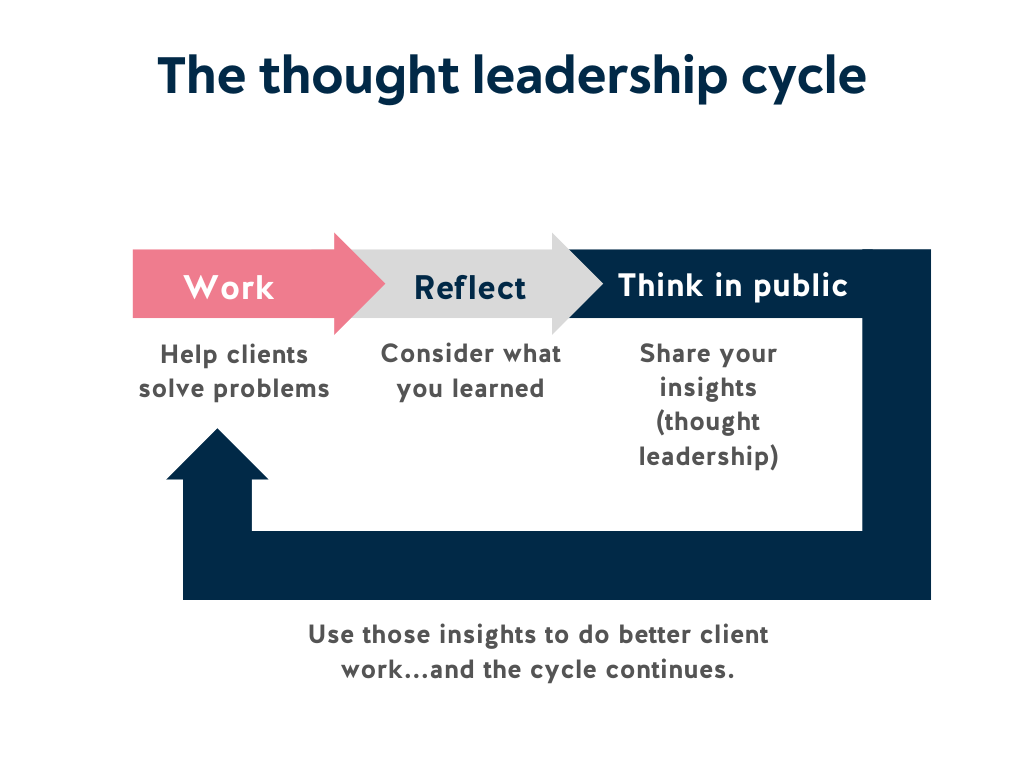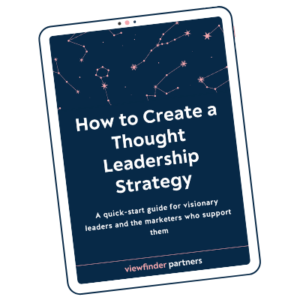How can normal people turn their work into thought leadership? If you aren’t creating thought leadership now, how could you squeeze it into your already full schedule?
A lot of people assume that thought leadership is for other people. But I’ve seen that thought leadership can and should be a part of most people’s everyday work habits. Building a thought leadership mindset into your routine can actually help you do better work for your clients.
Thought leadership is a clear, repeatable, 3-step process that starts with what you’re already good at — doing your work.
Thought leadership in 3 steps
Producing thought leadership can fit into your existing work habits. That’s because being a thought leader starts with doing good work. Here are the three steps in the thought leadership cycle:
- Do work for clients. Help your clients solve problems.
- Reflect on that work. Inevitably, each new client or project or challenge is going to bring up new snags, opportunities, and aha moments. This step is about reflecting on those insights. Notice what’s happening and what you’re learning. Reflection is a thought leader’s superpower.
- Document your insights through thought leadership. Share what you’ve learned.
Or to put it more simply:
- Work.
- Reflect.
- Think in public.

But here’s the real beauty: this process isn’t a one-and-done. It’s a cycle that loops back to the beginning. After #3, the process repeats. Apply those new insights to your next round of client work, keep learning, and keep sharing. It’s a fruitful, continuous cycle that helps you reflect on your work, get better at what you do, and share what you’ve learned to help others.
Common challenges thought leaders face
While this 3-step process seems simple, a lot of people struggle with the weighty idea of producing thought leadership. I’ve found a few common trouble spots. Often, people face challenges when:
They aren’t doing the kind of client work they want.
They’re missing the very first piece of the puzzle: do the work! Maybe they want to move into a new industry or offer a new service. But instead of finding a new client, trying a test project, and doing the work, they want to go backward. They want to share insights first. They want to write a book or make a podcast and then build a work practice around it. They’re hoping to unlock an “If you write it, the work will come” scenario.
But in my view, this is the wrong order. It’s putting the chicken before the egg. You should be writing about your insights after you’ve done the work to earn them.
Build your foundation of client work. After you’ve worked with a client (or ten), then you’ll be able to write about it.
They’re too busy to reflect on their work.
Who has time to reflect on work when there are deadlines to meet, new clients to sign, and people to manage? That’s the refrain I hear from people who are doing interesting work but have such a dizzying schedule that they can’t pause and investigate what they’re learning along the way.
This roadblock is the simplest to clear. Schedule time on your calendar (even 15 minutes at the end of the week) to review your work. Look back over the meetings you’ve held, conversations you’ve had with clients and teammates, and work you’ve delivered. What trends do you see? What questions keep coming up? What are your clients stressed out about, and how have you helped them? What are you still wondering about or trying to solve?
That simple reflection time will give you the questions you could address in your thought leadership.
They’re “not a good writer” or “not a thought leader.”
Some people are doing wonderfully interesting work in very creative ways. They have the time and presence of mind to reflect on their work. BUT, they are completely flummoxed by publishing anything. “Who, me, write?”
The good news is that you don’t have to be an accomplished writer to share your ideas and think in public. There are a lot of ways to get your ideas out:
- Maybe you prefer to communicate your ideas by talking to someone. Could someone on your team interview you about what you’ve learned?
- Could you try a non-written format like videos, podcasts, or speaking engagements to share your insights?
- Could you start with bullet points and share those?
- Could you write a LinkedIn post, but pretend you’re writing an email to a colleague you like and trust? Take some pressure off. You’re not writing your magnum opus. You’re just thinking out loud about your job.
Experiment with new ways to get your reflections out of your head and in front of other people.
If you’re having a hard time creating thought leadership or envisioning how you could ever be a “thought leader,” you’re probably getting stuck in one of these three steps – or trying to do them in the wrong order. If you do good work, reflect on what you learn, and share those lessons, thought leadership is within your reach.




![target practice [thought leadership is a practice]](https://viewfinderpartners.com/wp-content/uploads/2024/02/get-unstuck-300x300.png)


